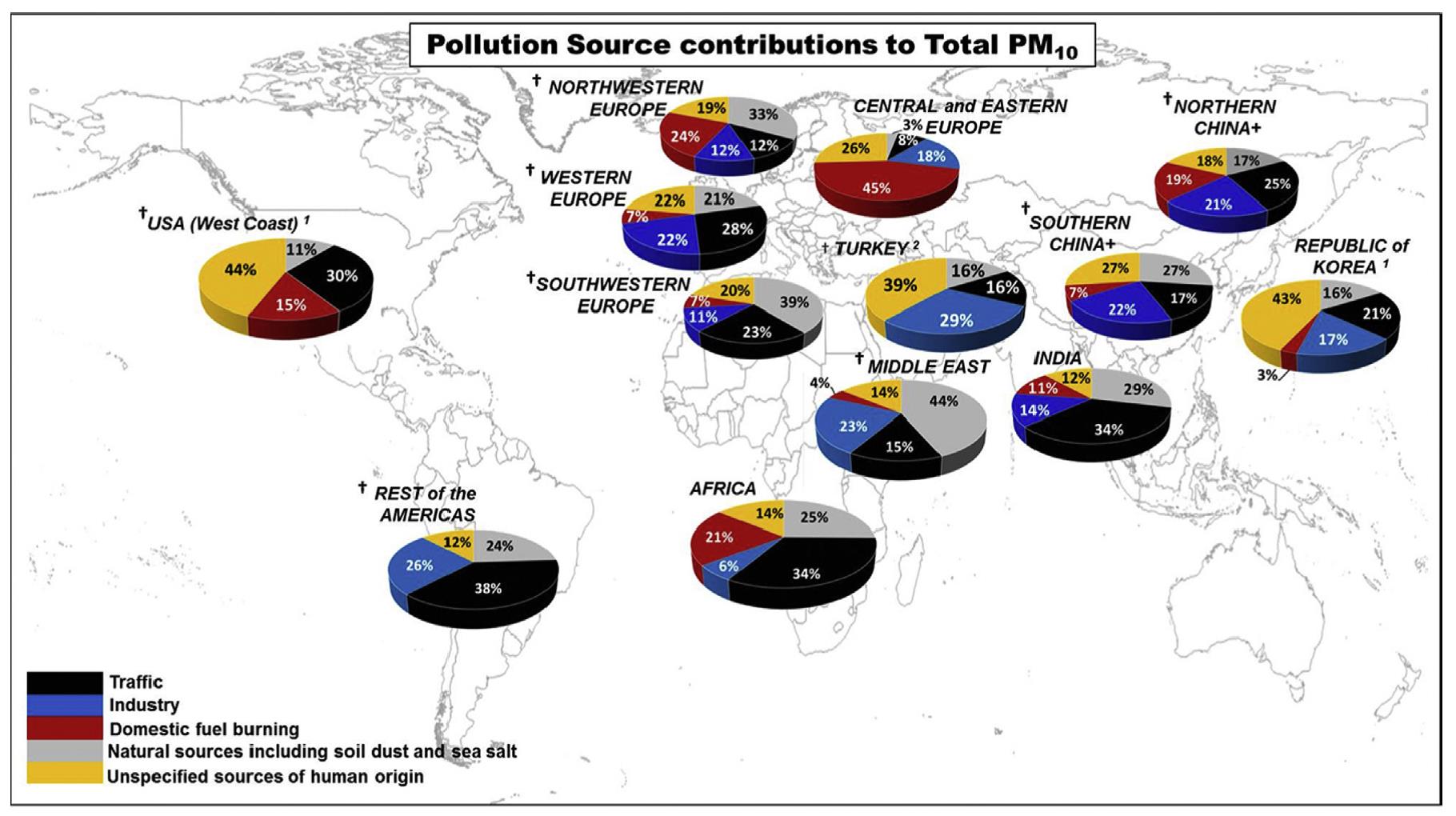Newsletter
You’ve likely seen the term PM10 floating around when researching air pollution and particulate matter. You might have also seen it brought up more recently in the context of raging wildfires. While PM10's smaller counterpart, PM2.5, often gets more buzz, PM10 is still a significant health threat and air pollutant.
PM10 is just a form of air pollution composed of tiny particles, right? Seems pretty self-explanatory, but there is more to the story. PM10 is a single category full of variety, as PM10 comes from a multitude of sources and in all kinds of forms. Similarly, how is PM10 different from PM2.5, another type of particulate matter?
In today’s article, we are going to shine some light on PM10 and its relationship with air quality.
PM10: How Particulate Matter Pollutes Our Air
4. How does PM10 affect air quality?
What Is PM10?
The abbreviation PM stands for particulate matter, and the number to the right indicates the particle size. So, PM10 refers to small particles of solid or liquid with an aerodynamic diameter smaller than 10 µm.
For reference, you could fit about 10 of these particles side-by-side in the width of a human hair! Pretty tiny, right?
While other air pollutant categories frequently use chemical formulas and chemical composition, particulate matter is unique in that it’s categorized by size rather than chemical makeup. Comprised of many different substances like mold spores, bacteria, dust, and smoke, PM10 particles are small enough to enter your lungs and cause damage throughout your respiratory tract.
Where Does PM10 Come From?
PM10 can originate from a variety of sources, both indoor and outdoor. The three main source categories are primary human emissions, secondary atmospheric reactions, and natural sources.
As the name implies, primary human sources are cases where particles are directly emitted from human activity. Some examples are the dust blown off of mines, slash-and-burn agriculture, road and construction dust, wood-burning stoves, and fossil fuel power plants.

Human activities like mining and construction produce PM10
Humans can also indirectly create PM10 through atmospheric chemical reactions. Other gases can undergo chemical reactions and form particulate matter, such as sulfur dioxide forming sulfates. While some coarse particles are created by such a process, these “secondary” particles are much more common for PM2.5.
There are also a bunch of natural sources of PM10 pollution, including dust storms, wildfires, sea spray, and pollen. For parts of Africa and the Middle East, a significant portion of particle pollution originates from dust blowing in from arid areas.

Image via https://ec.europa.eu/jrc/en/news/what-are-main-sources-urban-air-pollution
PM10 vs. PM2.5
One frequent question people have when learning about particulate matter is the difference between PM10 and PM2.5.
The key differentiator between these two particle types is size. PM10 contains particles 10 µm in aerodynamic diameter or small, while PM2.5 only includes particles of aerodynamic diameter smaller than 2.5 µm. You may notice that PM10 actually includes PM2.5, much like a nesting doll.
How Does PM10 Affect Air Quality?
As a significant air pollutant, PM10 has a negative relationship with air quality; as PM10 increases in the air, air quality worsens. PM10 readings are factored into overall AQI readings in several countries, such as the USA and China. You may find local AQI values through your government and personalized AQI readings through your air quality monitor.
PM10 particles hurt air quality because of their adverse effects on human health. Because PM10 is small enough to penetrate deep into the lungs, these particles can adversely impact your respiratory and cardiovascular system. Coarse particles don’t cause inflammation of the brain, as fine and ultra fine particles do, but they contribute to conditions such as cardiovascular disease, asthma, and allergies.
What PM10 Level Is Considered Healthy?
This is a bit of a trick question. Technically, there isn’t a safe level of PM10, as any amount of particulate matter in your air isn’t a good thing.
However, completely eliminating PM10 from your life isn’t a practical option. You will be exposed to coarse particles in some way during your day, but there are some guidelines you can follow to determine if the air is safe. Below, we’ve listed the EPA’s PM10 breakpoints for your reference:
|
EPA's PM10 Breakpoints |
||
| AQI | PM10 (in µg/m³) | |
| Good | 0-50 | 0-54 |
| Moderate | 51-100 | 55-154 |
| Unhealthy for sensitive individuals | 101-150 | 155-254 |
| Unhealthy | 151-200 | 255-354 |
| Very unhealthy | 201-300 | 355-424 |
| Hazardous | 301-400 | 425-504 |
| Hazardous | 401-500 | 505-604 |
| Hazardous | 501-999 | 605-9999 |
Keeping your exposure to PM10 concentrations below 54.0 µg/m³ is the best way to prevent any short or long-term health effects from developing.
How To Protect Yourself From PM10
So, what are some ways to protect yourself from PM10? Luckily, there are several ways to do this:
Check your local AQI readings
One of the simplest ways to protect yourself from PM10 pollution is to check your local AQI readings before venturing out. Armed with this knowledge, you will know if it’s safe to spend time outside exercising or playing with your kids. You can often find these values online or through air quality apps like the U.S.’s AirNow and Kaiterra’s own air quality app.
Wear a pollution mask
Sometimes, braving a pollution-heavy day is unavoidable. When this occurs, it’s best to wear a pollution mask. While pollution masks won’t filter out all of the PM10 dust floating in the air, good-quality pollution masks do keep out the majority when appropriately fitted. If you do go out when PM10 levels are high, wearing a pollution mask will protect you from the worst of it.
Use an air quality monitor
Particle pollution isn’t just an outdoor occurrence. In many cases, the air quality in your home can be far worse than ambient air quality, and knowing your local AQI alone won’t protect you from indoor PM10, especially if you use certain appliances like wood-burning stoves, fireplaces, and candles that release particulate matter into your home.
Air quality monitors provide data specific to your home, letting you know the exact air quality conditions you and your family are living in. With this tailored air quality data, you can make effective decisions to protect yourself, including when to turn on your air purifier, when it’s safe to open the windows, and where your indoor pollution is coming from. Speaking of air purifiers...
Pick up an air purifier
Air purifiers are great ways to directly remove PM10 from your air. Since most of us spend the majority of our lives indoors, taking care to eliminate PM10 from your home is paramount.
There are several types of air purifiers out on store shelves, but for effective air purification, you should make sure your purifier has a legitimate HEPA filter (and be wary of ionic purifiers in general). For more information about air purifiers, check out our FAQs.
Keep your home spick-and-span
Keeping your house clean is one of the most basic ways to limit exposure to PM10 inside your own home. Pollutants like dander, mold spores, and dust are all forms of PM10 readily thwarted by regular cleaning.
This rule applies to your tech, too. An air purifier will do more harm than good if it's full of mold, and your humidifier can also be a big polluter. Changing out the filters in your purifier and washing out your humidifier at least once a week will help prevent mold from taking root and dust from spreading around your home.
How Companies Can Prevent PM10 Exposure in the Office
Much of the advice related to protecting your home is equally applicable to the way companies should protect their employees in office buildings (and other types of commercial real estate):
Continuous Monitoring
Continuously monitoring indoor air quality using IoT-enabled monitors can help companies understand whether certain areas of the building suffer from higher levels of PM10 at certain hours, and make appropriate decisions to minimize exposure. For example, this could mean reducing outdoor airflow during wildfire season.

Office Air purifiers
The use of office air purifiers and better ventilation (through regularly maintained HVAC systems) can help reduce the presence of coarse particles. These devices work by filtering and sanitizing the air within the office environment, reducing the concentration of pollutants such as PM10 and PM2.5 in the ambient air. They typically employ filters, such as High-Efficiency Particulate Air (HEPA) filters, which are designed to capture minute particles.
Some advanced air purifiers come with additional features like carbon filters for odour removal, UV light for germicidal action, and ionizers to pull down suspended particles. Alongside particulate matter, they can effectively remove allergens, microbes, and volatile organic compounds (VOCs).
Hygiene and Cleaning
Maintaining hygienic workspaces and ensuring buildings are regularly cleaned can help prevent coarse particles from accumulating. Dusty areas or buildings close to major roadways might need to be cleaned more frequently.
As a form of particulate matter, PM10 is only one chunk of the air pollutants circulating in the air we breathe. For the rundown on air pollution and what you need to know, take a look at our air pollution page!






.png?width=200&height=148&name=Menu%20C%20(2).png)

.png?width=307&height=228&name=Menu%20-%20D%20(1).png)
.png)





